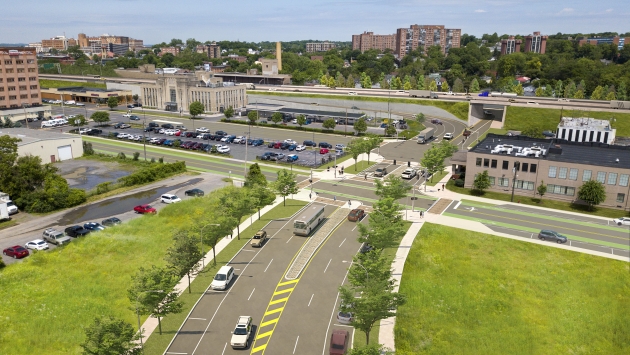The New York State Dept. of Transportation is moving toward breaking ground on a $2.3-billion interstate highway replacement project in Syracuse, but advocates are pressing the agency to plan for more protections to ensure the work does not expose locals to lead or other health risks.
Advocates with the New York Civil Liberties Union said updates to the I-81 viaduct project addressed some of their concerns, including a DOT commitment to establish a land use working group with community members. However, in a May 16 letter to officials, the group said the state had not addressed all the issues it raised about the health of people living near the work area, particularly relating to the potential for lead exposure linked to the existing viaduct’s demolition.
The lead exposure plan that NYSDOT has in place is focused on protecting workers, but not people living nearby, said Lanessa Owens-Chaplin, director of environmental justice project for New York Civil Liberties Union.
State DOT representatives did not immediately respond to ENR's inquiries about the NYCLU’s claims. The final environmental impact statement, which was released April 15, noted that it is assumed the structures have residual lead paint. Contractors on the project would need to submit a lead-exposure control plan for DOT approval and follow state safety standards for lead removal operations, including air monitoring and best practices for removal and disposal.
The NYCLU wants the DOT to conduct an area health assessment, plan for a greater level of protection than what’s in the current proposal, and provide residents with technology like mats that can catch lead off clothes. The group also said the DOT should establish a relocation center for any residents who will need to move for health reasons related to the project.
“They have addressed things like noise pollution and air pollution by creating an air monitoring program. They’re also establishing noise walls,” Owens-Chaplin told ENR. “But the one thing that still remains outstanding is the willingness to do some abatement or preventative work around lead. Lead is a significant problem here in Syracuse.”
As ENR previously reported, advocates with the NYCLU say the highway’s construction in the 1950s led to decades of economic and health impacts on the residents of the majority-Black neighborhoods where it was built. The highway cut people off from their jobs, grocery stores and health care, plus displaced residents were paid less than market rate for their homes, according to a NYCLU report.
In a press release announcing the final environmental impact statement, Gov. Kathy Hochul said the project “represents a historic opportunity to correct the errors of the past and remove a relic of outdated and ill-conceived highway planning that has for generations impacted residents, in particular communities of color.”
The plans for the I-81 viaduct project option preferred by state DOT call for the removal of the aging structure and rerouting part of the interstate onto another existing highway, I-481. Two interchanges where the highways meet would be reconstructed to direct traffic onto the new I-81 route.
The current path of I-81 running through downtown Syracuse would be redesignated as Business Loop 81. The business loop would feature traffic-calming measures and landscaping that state officials say would improve mobility and reconnect downtown neighborhoods.
The environmental impact statement includes several revisions to the preferred option proposal, including eliminating plans for a roundabout near an elementary school. Instead, it adds plans for a roundabout three blocks north.
First Phase Contracting
DOT officials said they planned to break ground in the fall. On April 22, the department released the short list of three design-build teams vying for the first contract of the project. Officials estimate the value of that contract between $250 million and $300 million. It will include construction of an additional lane on both the northbound and southbound sides of the current I-481, rehabilitation and widening of several bridges, and reconstruction of an existing I-81/I-481 interchange.
The short list of teams selected to submit for the RFP include:
- Cashless Tolling Constructors LLC dba CNY Alliance with A. Servidone/B. Anthony JV, Rifenburg Construction Corp., Economy Paving Co. Inc. and Crane-Hogan Structural Systems Inc. with designers Stantec Consulting Services Inc. and KC Engineering and Land Surveying, inspection by Prudent Engineering and material testing by Atlantic Testing Laboratories.
- A joint venture of Lane Construction Corp. and Barrett Paving Materials Inc. with designers Jacobs Civil Consultants Inc., T.Y. Lin International Engineering & Architecture and Barton & Loguidice, plus M&J Engineering for inspections and Atlantic Testing Laboratories.
- Salt City Constructors LLC submitted with Lancaster Development and Tully Construction Co. LLC dba L&T Construction, D.A. Collins Construction Co. Inc. and Cold Spring Construction Co. Inc. plus designers HNTB New York Engineering and Architecture and Bergman Associates, inspectors from LiRo Engineers Inc. and material testing by Advance Testing Company Inc.
Work on the project is expected to take six years, according to DOT documents.





